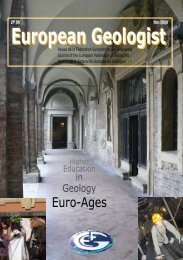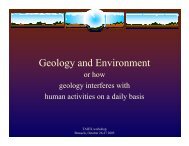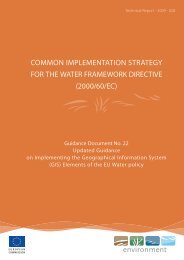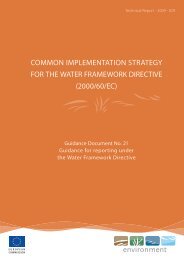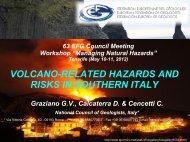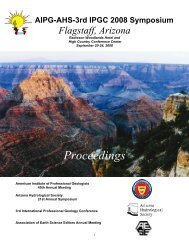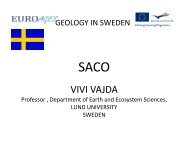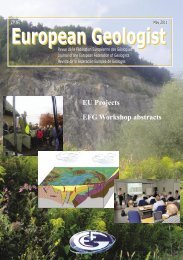European Geologist European Geologist Geoheritage - learning ...
European Geologist European Geologist Geoheritage - learning ...
European Geologist European Geologist Geoheritage - learning ...
Create successful ePaper yourself
Turn your PDF publications into a flip-book with our unique Google optimized e-Paper software.
Topical - <strong>Geoheritage</strong><br />
Figure 2: Rocher de Freyr – protected rock outcrop (Dinantian<br />
limestones).<br />
Figure 3: Underground quarry (building stone = Maastricht limestone)<br />
: site protected for cultural reasons (Caestert quarry, Kanne):<br />
medieval graffiti on the wall (photograph: Bert Beckers).<br />
<strong>Geoheritage</strong> potential in Belgium<br />
The geology of Belgium forms the stage<br />
where a large part of Earth’s history has<br />
been elucidated: indeed, geologists make<br />
worldwide use of chronostratigraphic<br />
stage names coined in Belgium (Rupelian,<br />
Ypresian, Visean, Tournaisian, Famennian,<br />
Frasnian) or derived from border towns<br />
where part of the type section is located in<br />
Belgium (Maastrichtian, Givetian) (Fig.1).<br />
As the legacy of pioneering 19 th century<br />
geologists such as André Dumont and<br />
Jules Gosselet, these stage names belong<br />
as much to the global cultural heritage as<br />
they refer to the local rock outcrops and<br />
quarry sites in the historical name-giving<br />
areas. If Belgian geologists had been more<br />
attentive, this list could have been longer<br />
and include, e.g. Landenian or Couvinian<br />
(Dejonghe, 2006). It is primarily the responsibility<br />
of present and future generations of<br />
academic geoscientists to preserve the value<br />
of these names and of regional geoscientists<br />
to maintain the link between the historical<br />
type areas and the preserved geoheritage.<br />
The classical Meuse profile between Namur<br />
and Givet, displaying different facies for<br />
the Palaeozoic international<br />
stage names, is hailed as one<br />
of world’s finest showcases of<br />
a geological succession in an<br />
orogenic belt (Fig. 2).<br />
Besides the sites and sections<br />
linked to the chronostratigraphic<br />
stages, Belgium<br />
possesses emblematic<br />
natural heritage sites with a<br />
long history of human curiosity<br />
about their geological<br />
character. These sites where<br />
underground expeditions<br />
took place, before geology as<br />
a science or the stratigraphical<br />
time scale were established,<br />
were the precursors to geotourism.<br />
Examples are; the<br />
natural caves of Han-sur-<br />
Lesse, a model for a meander<br />
cut by an underground river,<br />
or the underground labyrinth<br />
of Montagne St Pierre created<br />
by room and pillar mining of<br />
the Maastricht stone, where<br />
the Mosasaurus hoffmanni<br />
was discovered in 1770 and<br />
subsequently deposited in<br />
the Muséum in Paris as a<br />
war trophy. Han-sur-Lesse<br />
is a popular showcave but<br />
has retained its importance<br />
for geological research. The<br />
underground quarries of Montagne St<br />
Pierre have been destroyed by open cast<br />
quarrying but efforts are being made to<br />
protect the remaining underground quarries<br />
(Fig. 3).<br />
The recent morphological evolution<br />
- epeirogenic uplift with river incision<br />
- has exposed many more rock outcrops<br />
or allowed their exploitation, showing<br />
more than 500 million years<br />
of geological history in a<br />
restricted territory (Dejonghe<br />
& Jumeau, 2007). This has<br />
resulted in a legacy of rock<br />
sections, type sections and<br />
quarry sites of high regional<br />
stratigraphical and educational<br />
value (Fig. 4), many<br />
if not most of which are<br />
threatened by oblivion and<br />
only occasionally the subject<br />
of conservation. Fossil and<br />
mineral occurrences sometimes<br />
produce new minerals<br />
(e.g. minerals first described<br />
from Belgium, Hatert et al.,<br />
2002; Van Der Meersche et al.,<br />
2010) or exceptional fossil finds unmatched<br />
elsewhere in the world (e.g. the Neogene<br />
whales of Antwerp, or the Cran aux Iguanodons<br />
in Bernissart, now the showcase of the<br />
Natural History Museum in Brussels). The<br />
industrial basin along the Meuse - Sambre<br />
- Haine rivers was the start of the industrial<br />
revolution on the <strong>European</strong> mainland,<br />
fuelled by coal but with a rich and diversified<br />
tradition of mineral extraction and<br />
manufacturing (Goemaere et al., 2010).<br />
Nowadays, its geoheritage is concealed<br />
whereas the industrial heritage is acquiring<br />
UNESCO World Heritage status (n° 1344).<br />
Despite greening of the landscape, back<br />
filling and the obligation to flatten slopes<br />
of closed extraction sites, a number of<br />
geosites still exist in some regions, while<br />
in other regions former outcrops need to<br />
be exhumed to display any contact with the<br />
geological substrate. An inventory and classification<br />
of these geosites including their<br />
values and threats needs to be updated.<br />
With respect to the industrial and mining<br />
heritage, many initiatives for conservation<br />
and development are already operational (cf<br />
Dejonghe et al., 2009). Also, nature reserves,<br />
natural parks and regional landscapes often<br />
possess sites of geoscientific interest. The<br />
insight that their preservation contributes to<br />
ecosystem diversification is gaining ground<br />
(Fig. 5). Indeed, new threats arise from the<br />
vigorous restoration of more natural ecosystems.<br />
Vulnerable landforms, resulting<br />
from past and abandoned forms of land<br />
use may be sacrificed, e.g. the blow-outs<br />
uniquely preserved in the Bocholt plain (NE<br />
Limburg) have been levelled to create new<br />
nature areas.<br />
A special category of urban geology,<br />
historic monuments, whose raw material<br />
source may have been lost in time, forms<br />
Figure 4: The Beauchateau quarry: type section for Upper Frasnian<br />
red mud mounds with a high educational value. Site also cherished<br />
for outdoor activities and rock climbing (photograph: Pierres et<br />
Marbres de Wallonie).<br />
<strong>European</strong> <strong>Geologist</strong> 34 | November 2012<br />
9



